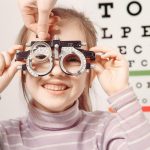
You’ve noticed your young child complains of headaches and rubs their eyes a lot. Does that mean it’s time to get glasses? It could, says a Baylor College of Medicine expert, and noticing these signs early is critical for young children because their schoolwork could suffer or they could lose their vision completely. “There is a period — approximately the first eight years of life — when the brain and the eye are learning to work together, and the visual system is still developing,” said Dr. Christina Weng, an assistant professor of ophthalmology at Baylor. “During this time, parents should watch out for behavioral changes because they can be a sign of potential eye problems.” “When children have trouble seeing, they often act out or exhibit other signs of stress, and it can be challenging to determine the cause of their behavior,” she explained. “It is very helpful for parents to pay attention to what situations trigger their behavior.” For instance, does your child become upset when watching a movie far away from the screen? Or does he or she avoid reading or other forms of near-sight work or seem to ignore people or objects in the distance? Any of those scenarios could point to potential vision trouble, Weng said. Additional symptoms associated with vision loss include: Frequent headaches Excessive eye rubbing Holding a book, phone… read on > read on >












-150x150.jpg)





